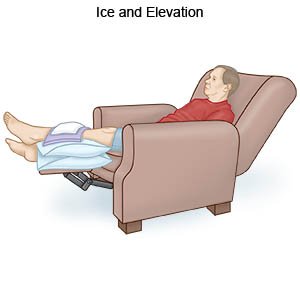Calcaneal Fracture
Medically reviewed by Drugs.com. Last updated on Aug 4, 2025.
What is a calcaneal fracture?
A calcaneal fracture is a break in your calcaneus (heel bone).
What are the signs and symptoms of a calcaneal fracture?
- Heel pain and inflammation
- Weak or numb heel
- Trouble moving or putting weight on your heel
How is a calcaneal fracture diagnosed?
- X-ray, MRI, or CT scan pictures may show a fracture or other damage. You may be given contrast liquid before the pictures are taken to help healthcare providers see your heel better. Tell the healthcare provider if you have ever had an allergic reaction to contrast liquid. Do not enter the MRI room with anything metal. Metal can cause serious injury. Tell the healthcare provider if you have any metal in or on your body.
- A bone scan may show a fracture or infection. You will get a radioactive liquid, called a tracer, through a vein in your arm. The tracer collects in your bones. Pictures will then be taken to look for problems.
How is a calcaneal fracture treated?
- A support device , such as a cast, splint, or boot prevents heel movement and helps your fracture heal. A support device may be the only treatment you need. You may need crutches to help keep weight off your heel.
- Medicine may be given to prevent or treat pain or a bacterial infection. You may also need a booster shot called Td to help prevent tetanus.
- Surgery may be needed if your heel bone broke into many pieces or your ligaments were damaged. You may need wires, pins, metal plates, or screws to hold the pieces in place while you heal.
What can I do to care for my heel?
- Rest your heel as much as possible. Return to normal activities as directed.
- Apply ice to your heel to decrease swelling and pain. Use an ice pack, or put crushed ice in a plastic bag. Cover the bag with a towel before you place it on your heel. Apply ice for 15 to 20 minutes every hour or as directed.
- Elevate your heel above the level of your heart as often as you can. This will help decrease swelling and pain. Prop your leg on pillows or blankets to keep your heel elevated comfortably.

- You may need to take showers until your healthcare provider says a bath is okay. If you have a cast, cover it with 2 plastic trash bags before you bathe. Tape the bags to your skin to keep the water out. Try to bathe with your foot out of the water in case the bag breaks.
- Go to physical therapy if directed. A physical therapist teaches you exercises to help improve movement and strength, and to decrease pain.
Call your local emergency number (911 in the US) if:
- You suddenly feel lightheaded and short of breath.
- You have chest pain when you take a deep breath or cough.
- You cough up blood.
When should I seek immediate care?
- You have severe pain.
- Your cast breaks or gets damaged.
- Your toes are numb, swollen, cold, or pale.
- Your leg feels warm, tender, and painful. It may look swollen and red.
When should I call my doctor?
- You have a fever.
- You have new blood stains or a bad smell coming from under your cast.
- You have increased pain or swelling, even after treatment.
- You have questions or concerns about your condition or care.
Care Agreement
You have the right to help plan your care. Learn about your health condition and how it may be treated. Discuss treatment options with your healthcare providers to decide what care you want to receive. You always have the right to refuse treatment. The above information is an educational aid only. It is not intended as medical advice for individual conditions or treatments. Talk to your doctor, nurse or pharmacist before following any medical regimen to see if it is safe and effective for you.© Copyright Merative 2025 Information is for End User's use only and may not be sold, redistributed or otherwise used for commercial purposes.
Further information
Always consult your healthcare provider to ensure the information displayed on this page applies to your personal circumstances.
